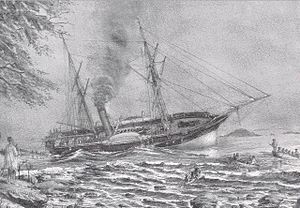HMS Hydra (1838)

Hydra's sister-ship, Hecate, aground near Cape Flattery in 1861
|
|
| History | |
|---|---|
| Name: | HMS Hydra |
| Namesake: | Hydra |
| Ordered: | 18 September 1837 |
| Builder: | Chatham Dockyard |
| Cost: | £37,239 |
| Laid down: | January 1838 |
| Launched: | 13 June 1838 |
| Out of service: | 13 May 1870 |
| Fate: | Sold for breaking up |
| General characteristics | |
| Class and type: | Hydra-class sloop |
| Displacement: | 1,096 long tons (1,114 t) |
| Tons burthen: | 814 91⁄94 bm |
| Length: |
|
| Beam: | 32 ft 10 in (10.01 m) |
| Draught: | 13 ft (4.0 m) |
| Depth of hold: | 20 ft 4 in (6.20 m) |
| Installed power: | 220 nhp |
| Propulsion: |
|
| Sail plan: | Brig rig |
| Speed: | 9 knots (17 km/h; 10 mph) (under steam) |
| Complement: | 135 |
| Armament: |
|
| Service record | |
| Commanders: |
|
| Operations: |
|
HMS Hydra was the lead ship of her class of wooden steam paddle sloops of the British Royal Navy, launched in 1838 at Chatham Dockyard. After taking part in operations during Syrian War in 1840, she then served on anti-slavery operations and also as a survey vessel. She was scrapped in 1870.
Hydra was commissioned on 19 January 1839 under Commander Anthony William Milward to operate in the Mediterranean Sea. After Milward's death in early 1840 Commander Robert Spencer Robinson was appointed to her.Hydra then saw action during the Syrian War, as part of a squadron under the command of Commodore Charles Napier (the ships Powerful, Ganges, Edinburgh, Revenge, Benbow, frigate Pique, and steamer Gorgon) operating off the coast of Ottoman Syria. In Admiral Sir Robert Stopford's report on the Anglo-Austrian-Turkish landings in September 1840 he noted that the steam vessels had been "eminently useful in constantly moving along a great extent of coast with troops and arms, and taking part in the attacks upon the different forts".
...
Wikipedia
